Radon
Welcome
Don't Guess, Test.
Your Radon Guide

Test your home for radon and reduce your risk of radon-induced lung cancer.
First Step
I am a
Have you tested
Disclaimer
Disclaimer
This guide is interactive - you will be asked questions throughout, which are used to personalize the information to your needs. You are free to choose whether to respond or not (responses are optional).
Analytics data from your session is aggregated and used to improve the experience for other users.
For more information see our privacy policy
I understand and consent to my information being collected.
Do you plan on testing
Kit basics
Step 1 / 4 : Before you start...
Select a location
Your radon detector will be in place for 3+ months. Set it up somewhere where it will be out of the way and undisturbed (but not forgotten).
When you are thinking of where to set up the device, keep these tips in mind:
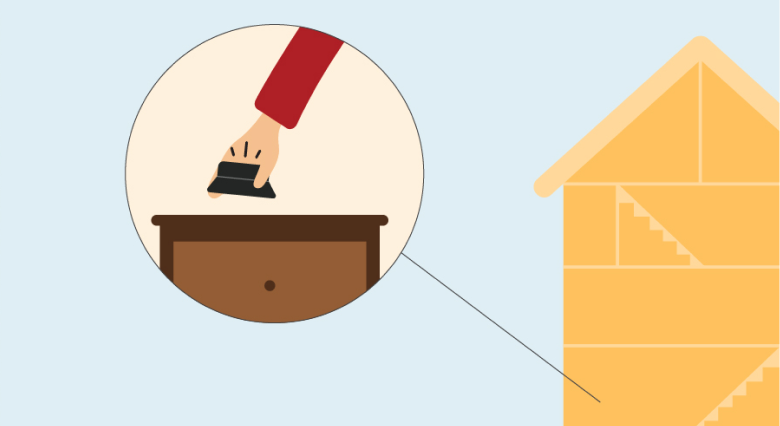
DO place the detector…
- On the lowest lived-in level of your home — where you, your pets or your family spend at least four hours a day (family room, living room, den, playroom or bedroom).
- In the typical breathing zone (so, not too close to the floor, and not too close to the ceiling).
- Away from an exterior wall, and away from other objects to allow for normal air flow.
- On any flat surface like a desk, table or shelf, or hang the detector from the ceiling or on a wall.
DON’T place the detector…
- In the kitchen, bathroom, laundry room, closet or unfinished areas of the basement.
- On an exterior wall or near air vents, windows or doors.
- Near heat sources like a fireplace or radiator, or in strong direct sunlight.
- On or near electronics (TV, stereo, speakers, computer etc.) or appliances (fridge, microwave etc.).
Why not sure about testing
dont think at risk
You answered:
I don't think I am at risk
A lot of people feel the same way. Radon can’t be seen or smelled, and there aren’t immediate symptoms of exposure, so it can be easy to ignore the risks.
However, exposure to elevated levels of radon can cause lung cancer – it’s the #1 cause of lung cancer for non-smokers. It’s estimated that 30% of lung cancer deaths in Canada are non-smokers.
Lung cancer is the most common cancer in Canada and the survival rate is low, so testing and reducing your radon exposure is the best way to reduce your risk of lung cancer if you don’t smoke.
Don’t gamble with your health or that of your family and pets. The only way to really know if you are at risk is to test the radon level in your home.
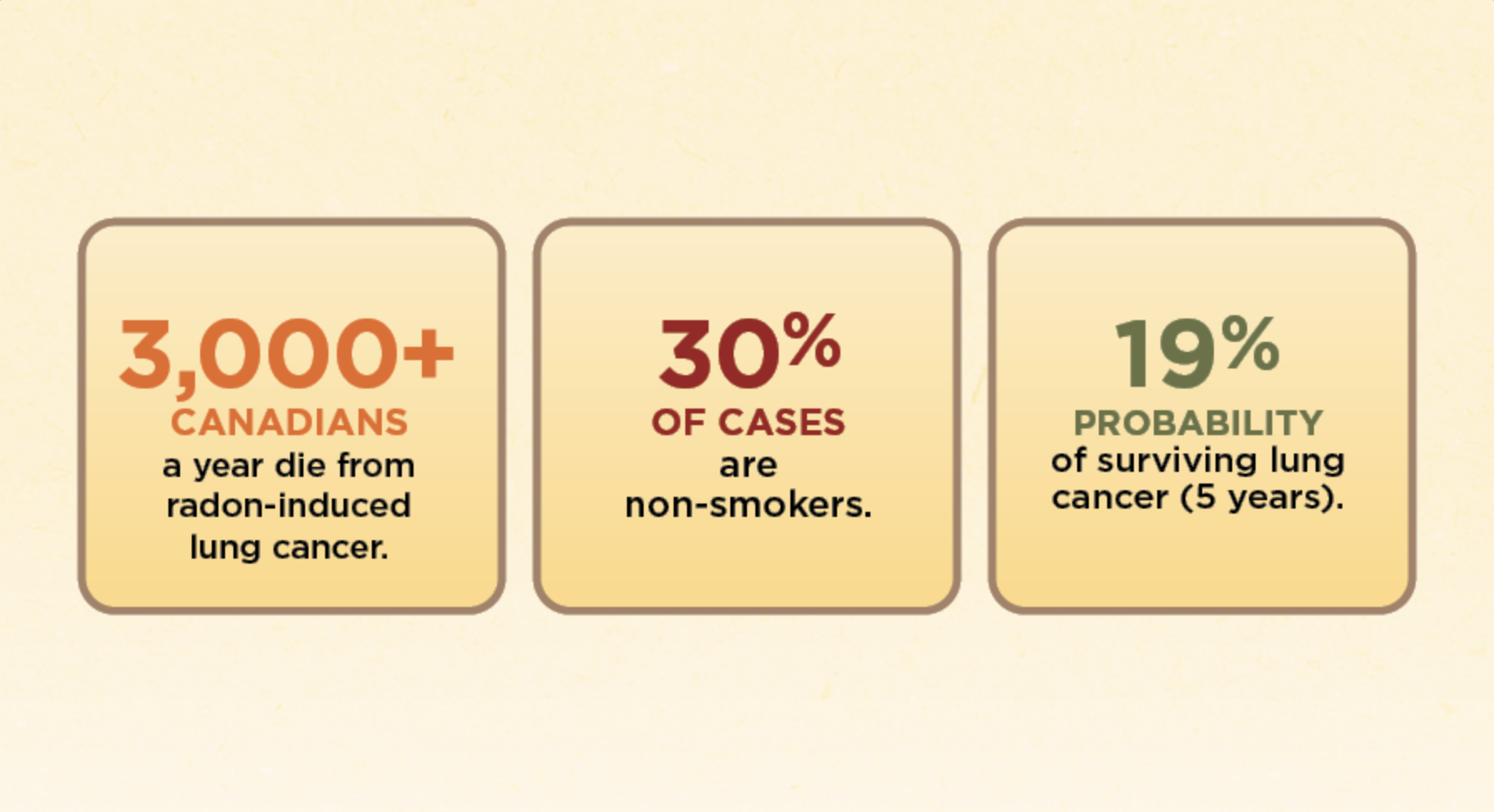
Cost
You answered:
It'll cost too much
Testing for radon is simple and relatively inexpensive, especially when comparing the long-term health risks of doing nothing!
Test kits are available for sale online and will be shipped directly to your home. Follow the instructions and set up the radon detector, leave it in place for 3+ months, then send the kit to the lab, and your results will be sent straight back to you.
If your results tell you your radon level is high, you can reduce it by installing a mitigation system - a certified professional can help. A mitigation system can be installed in less than a day and will reduce radon levels by 80-90%, often for less than the cost of replacing your furnace or air conditioner. The Lungs Matter: Home Radon Mitigation Grant Program provides some funding for low- or moderate-income households and Canadians that have been diagnosed with lung cancer.
Dont know enough
You answered:
I don't know enough about it
Radon is a naturally occurring radioactive gas that comes from the breakdown of uranium in the ground. All homes have radon – the question is, how much.
Over time, it can easily accumulate in our homes undetected.
Too many Canadians aren’t aware of the risks that elevated levels of radon have on their health, and that of their family and pets.
Radon exposure is the #1 cause of lung cancer in non-smokers. People who are exposed to radon and smoke are at even greater risk.

DELETETHIS
DELETETHIS
DELETETHIS
DELETETHIS
You, another adult, a child, and a pet spend around 18 hours per day at home.
On average, other people in your area, and living in a house built within that time period may be exposed to around [insert radon amount bq/m3 here].
Slide the scale to see your household's risk if exposed to different amounts of radon.
*The only way to know how much radon you have in your home is to TEST!*
DELETETHIS
The radiation from radon can put you and your family at risk for lung cancer, depending on the level of radon and the length of time you're exposed for.
Test your home to find out whether you need to reduce the level of radon you're exposed to.
Radiation explainer
Don’t take the risk
The radiation from radon can put you and your family at risk of lung cancer in the future.
Test your home to find out whether you need to reduce the level of radon you are exposed to.
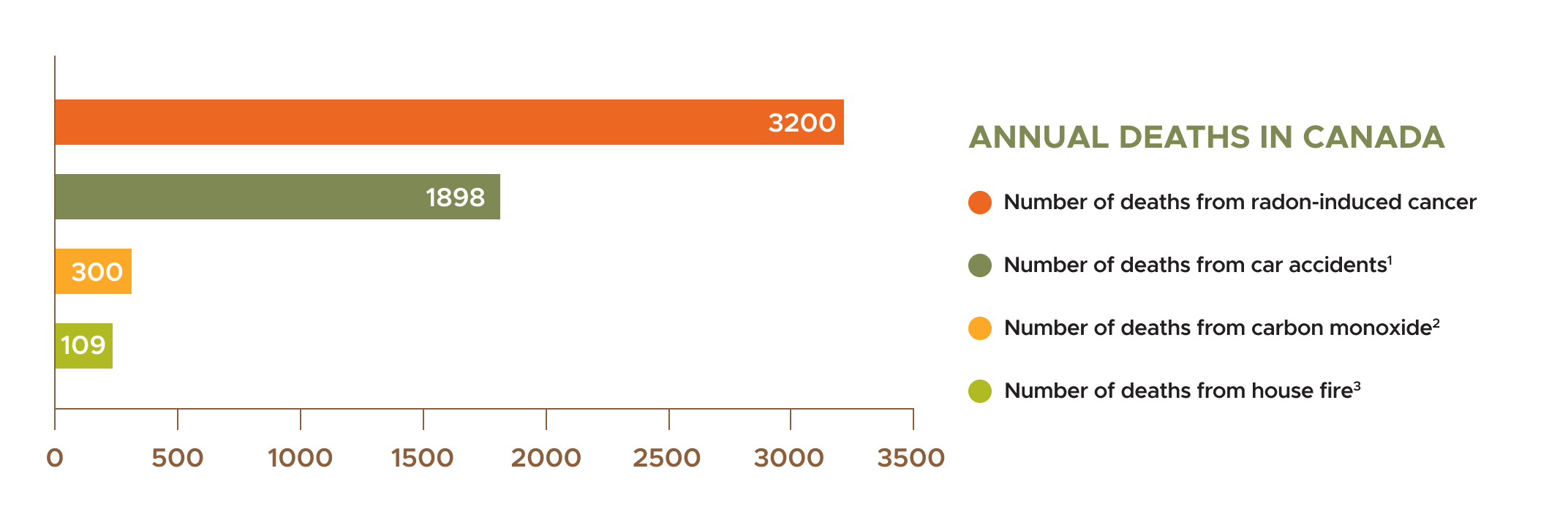
Testing steps graphic
The steps are simple and effective:
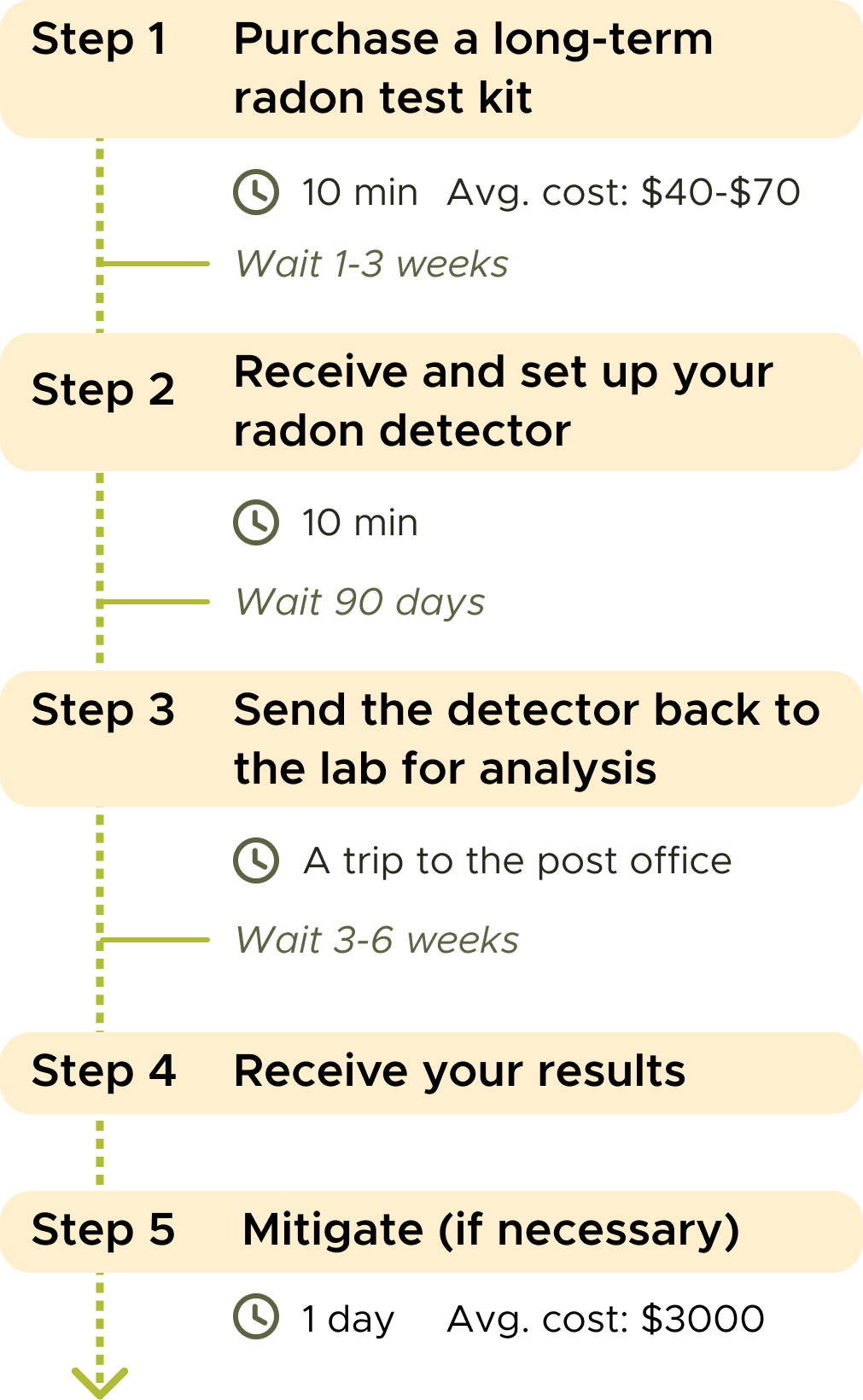
Things to keep in mind
Things to keep in mind when choosing a radon test kit
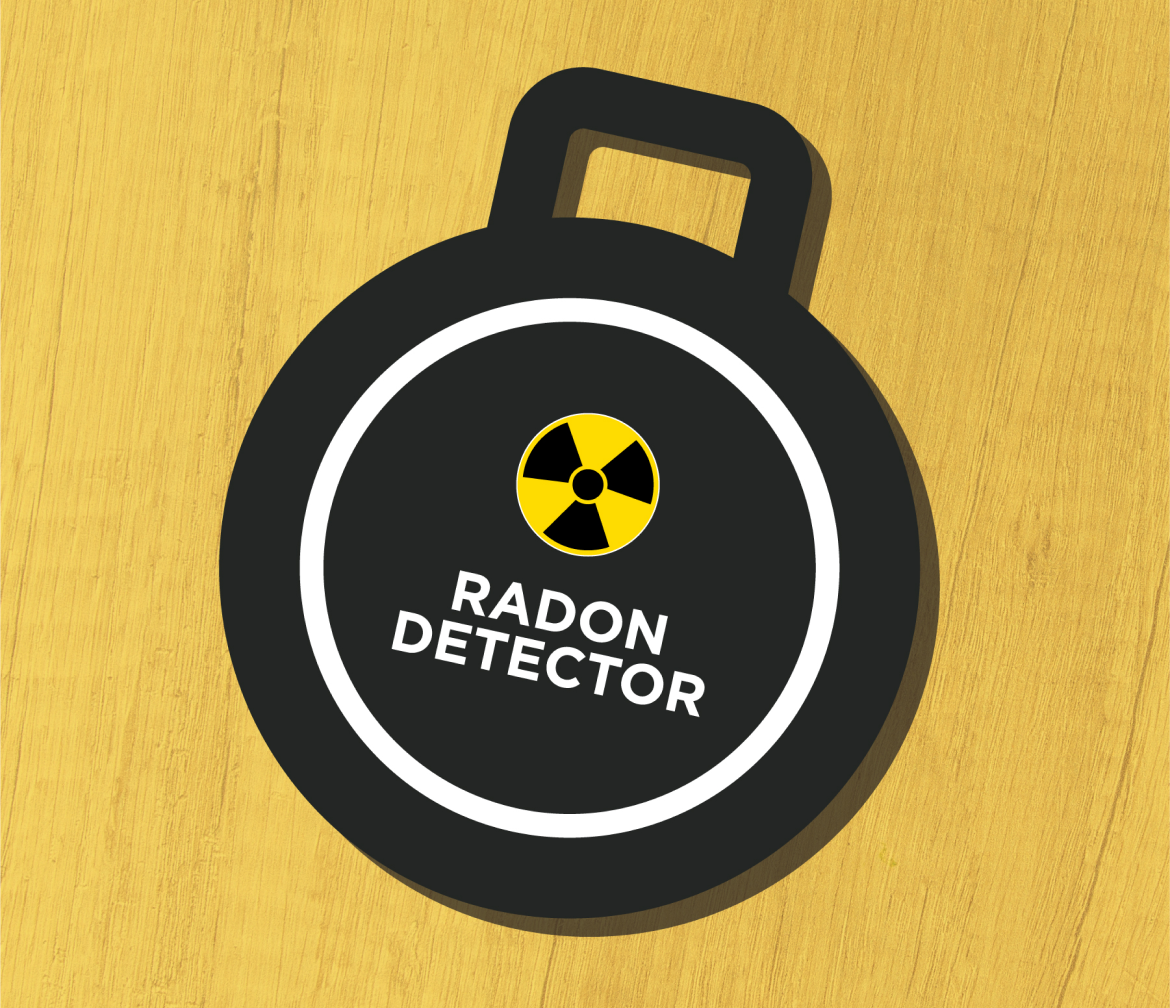
- Make sure it's a long-term test kit (3+months)
- Select a test kit provider that is listed on TakeActiononRadon.ca Check that the lab/processing fees and return shipping costs are included in the purchase price.
- Contact Health Canada's National Radon Program if you have questions - 1-833-723-6600 or radon@hc-sc.gc.ca
Links and resources
Ready to get your radon test kit?
You can order a certified test kit online - it's easy and inexpensive, and the kit will be delivered directly to your home.
Visit Take Action on Radon to purchase a radon detector. All the test kit providers on this website sell approved long-term radon detectors.
I'm not ready just yet..
ADD REMINDER FIELD HERE
DELETETHIS
What is radon? Who is at risk? Where?
Main health risks
Kit placement
Step 2 / 4 : Starting the test...
Get started
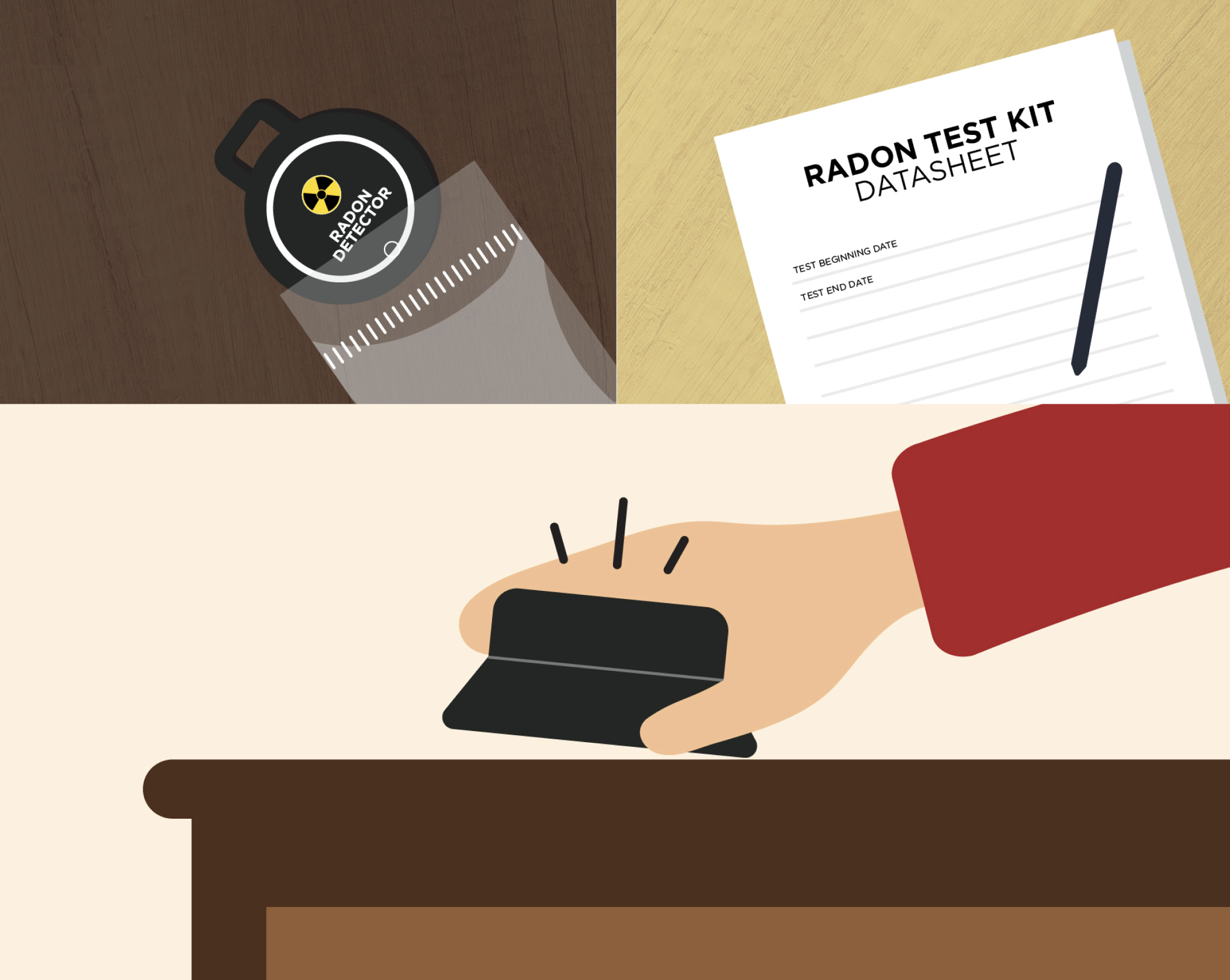
- Take the detector out of its packaging and place it in your chosen location. Make sure you have read all the instructions!
- Fill in the forms with the date/time/place you set up the detector.
- Put the forms, instructions and return envelope in a safe place (you’ll need them in a few months!)
TIP: take a picture of the test kit instructions and lab info – just in case you misplace them.
Faq
Step 4 / 4 : Set-up FAQs...
Frequently Asked Questions
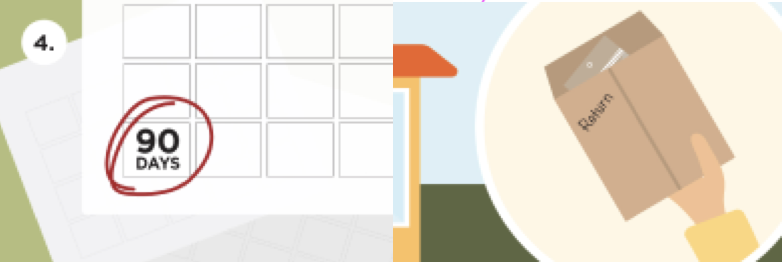
How much do radon test kits cost?
There are a number of companies that offer DIY radon test kits. They range in costs but usually fall in the $40-$70 range. Do some comparison shopping, just make sure the test kit is long term and listed on the TakeActiononRadon.ca website.
Are there additional costs to testing?
Many test kits come with lab fees and return postage included, but not all. Make sure you check that before you make your purchase.
Why buy a long-term test? I have seen some that only take a couple of days to do.
Health Canada recommends testing for a minimum of 3 months. Radon concentration varies by day and by week, so measurements taken over a longer period of time will give a more accurate indication of the radon level in your home. A long-term test is designed to measure radon levels for 3-12 months.
I haven't heard of anyone in my neighbourhood having issues with radon, so why should I worry?
Lung cancer is the most common cancer in Canada and the survival rate is low. It's your choice but testing and reducing your radon exposure is the best way to reduce your risk of lung cancer if you don't smoke.
My house is new, so that means that radon levels are probably low, right?
Both new and old homes can have high levels of radon. The age of a house isn't a good indicator of potential radon levels. Although older homes can be assumed to have more radon entry points (like cracks in the foundation etc), newer homes tend to be more energy efficient and tightly sealed which can increase radon levels.
I live in an apartment - should I be concerned about radon?
Radon enters buildings from the ground, so radon levels are typically highest in the basement or on the ground floor. However, radon gas can move through a structure, so the best option is to test to be sure.
My family spends time in different parts of the house, depending on the day of the week. Should I move the detector so that it's always in the rooms we are using most?
Once you have placed the device, it is best to leave it untouched until it's time to send it back to the lab. Don't worry though, the devices are quite stable so limited movement (like if someone picks it up or moves it accidentally) will not affect your results.
I feel fine - so my house can't have high radon levels, can it?
Exposure to radon won't make you noticeably sick right away. When you breathe it in, radon gas naturally breaks down into radioactive particles which damage lung tissue and can develop into lung cancer over time.
Radon levels can't /are too hard to fix, so why bother testing?
Radon levels can be reduced quite easily. Certified radon mitigation professionals are available across Canada. Radon levels in most homes can be reduced by more than 80% for about the same cost as other common home repairs such as replacing the furnace or air conditioner.
You can also add your cell phone number, and we will text you an automatic reminder in 3 months:
DELETETHIS
DELETETHIS
Sent testing kit
DELETETHIS
Do you have kit?
Kit set up
Let's set up the radon detector - it should only take a few minutes.
Please remind me to install my radon detector
PHONE INPUT HERE
Received results?
Result above 200
Above guideline
Your home is above the Canadian guideline for radon in indoor air.
The higher the level in your home, the sooner it needs to be fixed. Contact a certified radon professional to determine the best and most cost-effective way to reduce radon levels in your home.
Contact Health Canada's National Radon Program if you have questions - 1-833-723-6600 or radon@hc-sc.gc.ca
Click here to see available radon mitigation funding programs
Below guideline
That’s great! Your home is below the Canadian guideline for radon in indoor air.
You do not need to take action to reduce your radon levels at this time. Consider re-testing if you do any renovations or retrofits that will make your home more airtight, like adding insulation or replacing windows.
Installed when?
Return test
When it's time to send in your test kit, follow these steps.
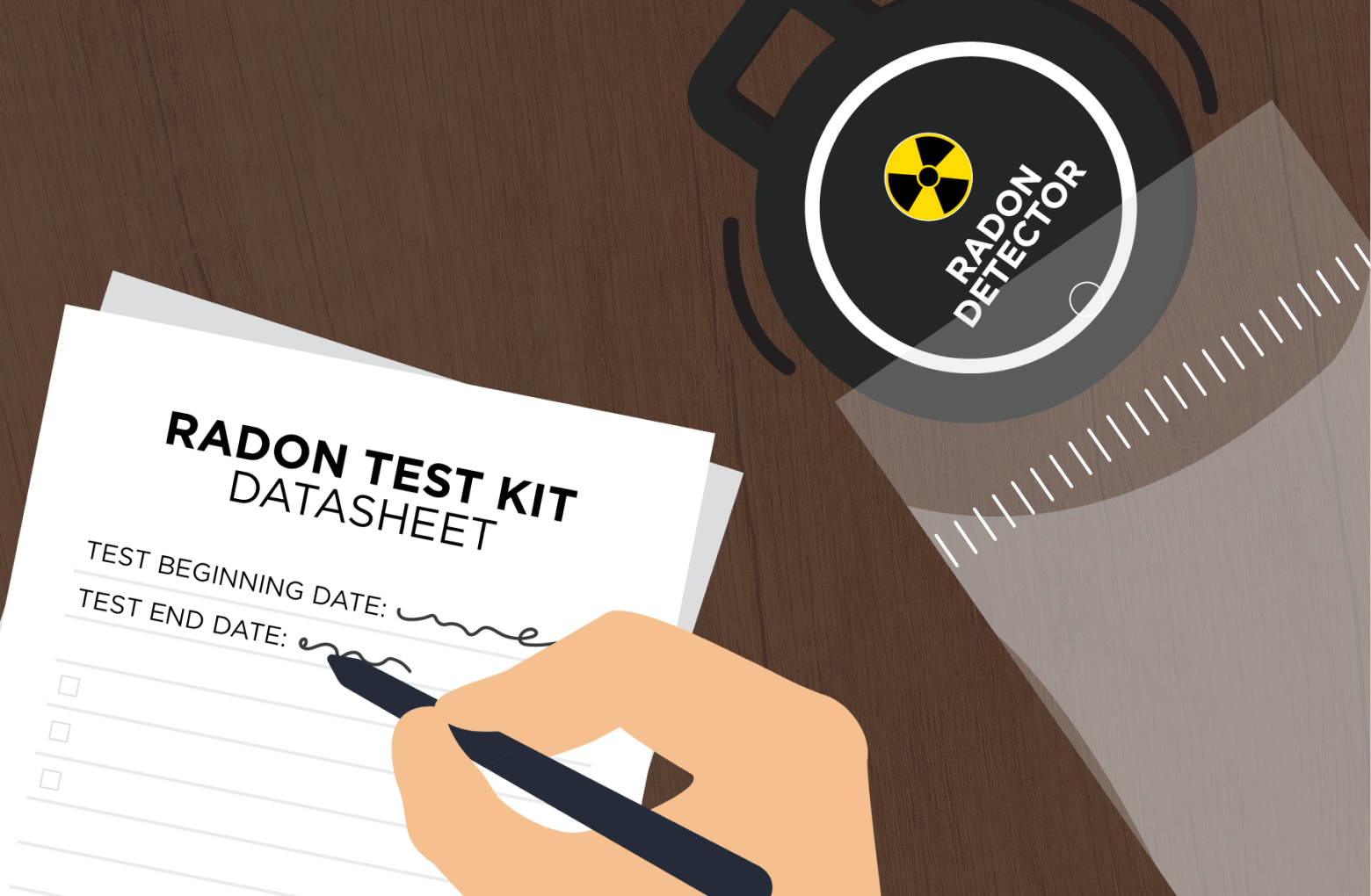
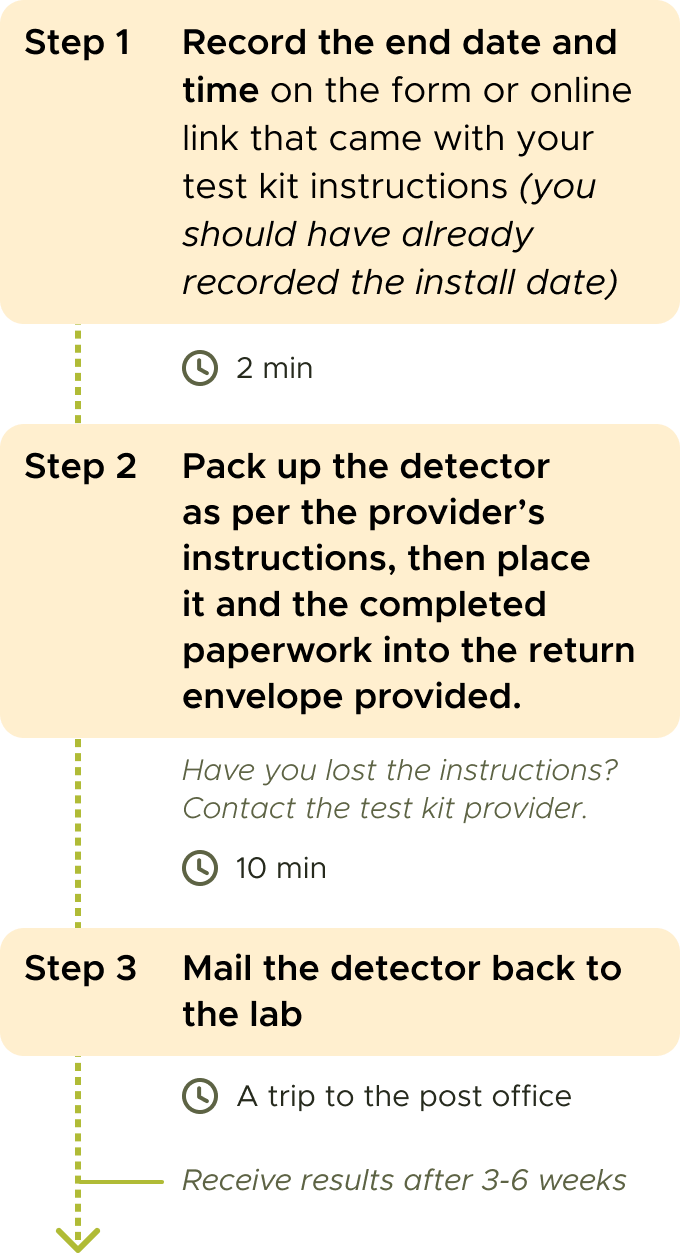
Capture accurate reading
Accurate results
In order to capture an accurate reading, long-term radon tests must be active for at least 90 days / 3 months.
DELETETHIS
Remind send back
Almost done! Now you just need to return the detector back to the lab for analysis.
- Collect your test kit materials. You will need the detector itself, as well as the instruction sheet, forms and return envelope the detector came with.-contact the test kit provider if you have misplaced the return instructions
- Package up the detector as per the instructions then place it and the completed paperwork into the return envelope provided.
- Mail your radon detector to the lab. - receive results after 3-6 weeks
TIP: take a picture of the test kit instructions and lab info just in case you misplace them.
DELETETHIS
Remind to send to lab
Remind to send to lab - desc
Congratulations
Congratulations! By testing for radon, you have taken an important step in keeping your home healthy.

Have your friends and family tested for radon yet?
Radon can put anyone at risk of lung cancer. Share this Guide to help your loved ones stay healthy too!
DELETETHIS
You should receive your results via email or mail in 3 - 6 weeks
If you results are 200bg/m³ or above, take action to reduce your radon level.
Check with me in 3 weeks
Your mobile phone number
[Phone number input here]
DELETETHIS
Installed test - three months
Return reminder
Step 3 / 4 : Set return reminder...
Return reminder
Leave the detector in place for at least 3 months (it’s okay if you keep it in place for longer, up to 12 months).
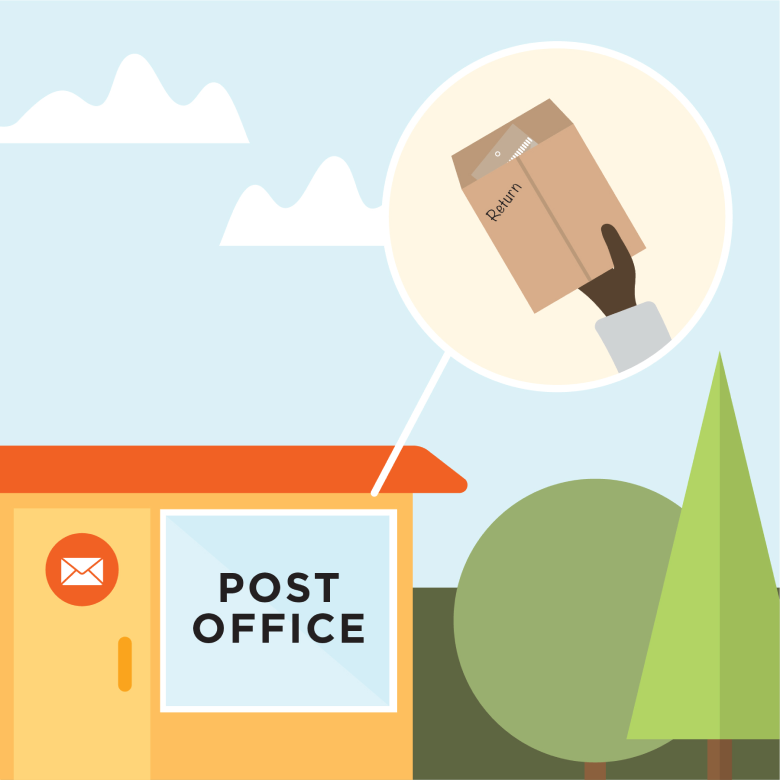
- Put a reminder in your calendar to return the detector 3 months after you set it up.
Tip- include a note to remind yourself where you put the instructions and return envelope! - Fill in the forms with the date/time/place you set up the detector – you will need that when it is time to mail the test kit back to the lab for analysis.
dont think at risk step two
You answered:
I don't think I am at risk
Don’t gamble with your health or that of your family and pets. The only way to really know what your risk is – and address if needed- is to test for radon.
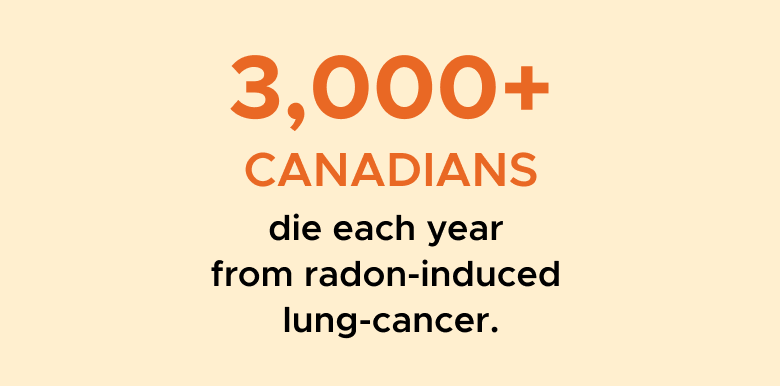
dont think at risk step three
You answered:
I don't think I am at risk
Don’t gamble with your health or that of your family and pets. The only way to really know what your risk is – and address if needed- is to test for radon.
Dont know enough step two
You answered:
I don't know enough about it
Too many Canadians aren't aware of the risks that elevated levels of radon has on their health, and that of their family and pets.
Radon exposure is the #1 cause of lung cancer in non-smokers. Lung cancer is the most common cancer in Canada and the survival rate is low. Testing and reducing your radon exposure is the best way to reduce your risk of lung cancer if you don't smoke. It's estimated that 30% of lung cancer deaths in Canada are non-smokers. People who are exposed to radon and smoke are at even greater risk.
Kit setup - reminder
Post reminder
Congratulations! You have taken an important step in keeping your home healthy. A reminder to check back in with this guide will be sent to you via sms!

Have your friends and family tested for radon yet?
Radon can put anyone at risk of lung cancer. Share this Guide to help your loved ones stay healthy too!
DELETETHIS
DELETETHIS
Reminder - Finish test
Send reminder when
Reminder-receive results
Faq with reminder
Links and resources - reminder
Above guideline with reminder
Results soon
Only ten minutes
Radiation - dont risk
Don’t take the risk
The radiation from radon can put you and your family at risk for lung cancer, depending on the level of radon and the length of time you're exposed for.
Test your home to find out whether you need to reduce the level of radon you're exposed to.
Received explainer
Your results are on the way!
You can expect the lab to send your radon results by email within 3-6 weeks after sending it in.
Your report will give you a result, expressed as Bq/m³ (bequerels per cubic meter) and will tell you if your test results are below or above the Canadian Guideline of 200Bq/m³.
Return test - its time
It’s time to send it your test kit. Follow these steps.


Above ending
By testing and taking the necessary steps to reduce radon levels in your home, you have taken an important step in protecting your health and the health of your loved ones.

Have your friends and family tested for radon yet?
Radon can put anyone at risk of lung cancer. Share this Guide to help your loved ones stay healthy too!
Congratulations - taken first step
Congratulations! You have taken an important step in keeping your home healthy.

Have your friends and family tested for radon yet?
Radon can put anyone at risk of lung cancer. Share this Guide to help your loved ones stay healthy too!
Reminder - Installed when
DELETETHIS
Welcome Step Three
Don't Guess, Test.
Your Radon Guide

Over time, exposure to a high radon level can cause lung cancer. In fact, radon is the #1 cause of lung cancer in non-smokers. There are simple actions you can take to reduce your risk – it all starts with testing your home to see whether your radon level is high or not.
DELETETHIS
Welcome Step Two
Don't Guess, Test.
Your Radon Guide
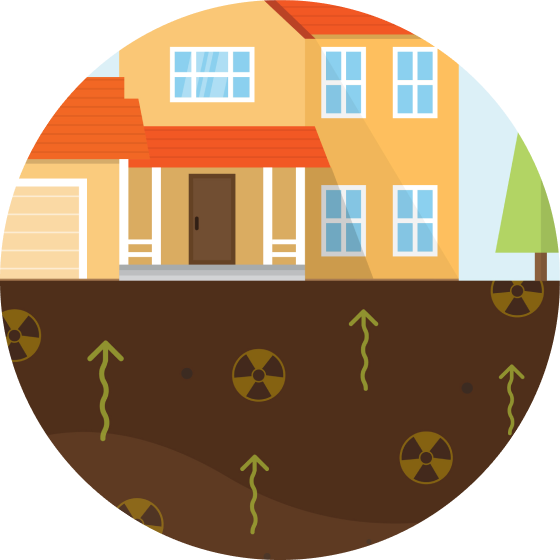
Radon is a naturally occurring radioactive gas that comes from the breakdown of uranium in rocks and soil. If your home has contact with the ground, you have radon. Question is – how much? The only way to know is to test.
DELETETHIS
Test H1
Test p tag
